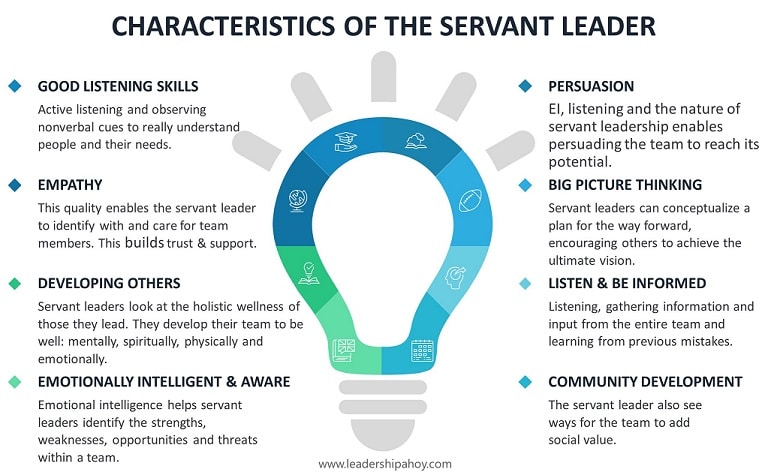Servant leadership has been a rare sight during my career as a CEO in the world of business. I am confident that Servant Leadership can be useful in business, especially in our modern times when corporate responsibility is becoming ever more important and many employees seek a cause they can support to serve the greater good. Servant leadership is the answer to many of these things.
What is Servant Leadership?
Servant Leadership focuses on improving people, society, and organizations. In Servant Leadership, the leader serves others, which leads to strong ethics, and engaged, motivated employees. A servant leader with too much focus on serving others can lose track of organizational goals and purpose.
This article explains Servant Leadership in-depth, with its history, pros and cons, characteristics, examples, and how to become a good servant leader. I also share some thoughts and stories on servant leadership based on my experience as a CEO. Check out our video on Servant Leadership below if you prefer that medium, or keep on reading for great insights on servant leadership and how to become a great servant leader.
Contents
- What is Servant Leadership?
- What Are the Characteristics of a Servant Leader?
- How is a Servant Leader Different from a Transformational Leader?
- What are the Pros and Cons of Servant Leadership?
- How Can You Be Effective at Servant Leadership?
- Servant Leadership – my story
- Who Are Some Examples of Servant Leaders?
- References
What is Servant Leadership?
It’s commonly thought that a servant is always at the lower end of the totem pole. That’s far from the truth. There are some leaders who transform the positive qualities of servitude into strong leadership qualities. This is the framework of servant leadership – one of the most humbling of all leadership styles.
Great servant leaders typically have good listening skills, lots of empathy, the ability to develop others, good persuasion skills, and big picture thinking abilities. Servant leadership often leads to high employee engagement, highly motivated employees, and a strong sense of ethics. Servant leadership can sadly lead to much focus on the individuals with less focus on the actual goals of the organization as a consequence. Furthermore, servant leadership is known to take a long time to establish and that is doesn’t work in all organizations. A servant leader needs to have very little or a complete lack of ego – this is an unusual trait among leaders.
Servant leadership was first conceptualized by Robert K. Greenleaf (in his 1970 essay “The Servant as Leader”[1]. He described two broad categories of leaders:
- Servant-first
- Leader-first
A person who is a leader-first is more concerned with exerting power and achieving personal gains. On the other hand, a servant-first leader puts people first. As Martin Luenendonk[2] states, “Servant leadership is something innate- the wish to serve is not something you instill in yourself, it is a feeling that comes from within.” Great care is taken to ensure that the highest priority needs are being met. The servant-first leader strives to help people grow and make a lasting positive impact on society.
Ultimately, a servant leader relinquishes most of his or her authority. It’s a completely selfless type of leadership that focuses on improving people at their core and organizations in their entirety. These are strong elements also present in democratic leadership style and transformational leadership style which you can find in our portal for leadership styles. (In fact, I suggest you take our democratic leadership course with lessons on inclusion, participation, and teamwork created by a CEO.)
What Are the Characteristics of a Servant Leader?
Greenleaf suggested that servant leaders should display eight qualities.

1. Good Listening Skills
A servant leader is only able to meet the needs of those being served if those needs are understood. Therefore, listening is important, especially active listening where a lot of questions are also asked. This leader should understand verbal and nonverbal cues in order to effectively discern the true needs that should be met. (Article tip: Why should leaders speak last?)
2. Empathy is part of servant leadership
Empathy is a big part of servant leadership. This quality enables the servant leader to identify with and care for team members. It’s a quality that helps build trust within the team and provides a struggling team member with the support needed to move forward.
3. Ability to Develop Others Holistically
There is much more to a person than the work he or she is able to produce. Servant leaders look at the holistic wellness of those they lead. They want their team to be well mentally, spiritually, physically, and emotionally. For an even more dedicated style on developing people, read about coaching leadership and how to create a leadership development plan.

4. Servant leaders have awareness
Servant leaders are emotionally intelligent. Help Guide[3] defines emotional intelligence as “the ability to understand, use, and manage your own emotions in positive ways to relieve stress, communicate effectively, empathize with others, overcome challenges and defuse conflict.” It has four attributes:
- Self-management
- Self-awareness
- Social awareness
- Relationship management
Emotional intelligence helps servant leaders identify the strengths, weaknesses, opportunities, and threats within a team. Equipped with this knowledge, the servant leader can work with the team to improve the organization. (Get a free copy of our E-book “7 Tips on How to Improve Your Emotional Intelligence” here: Emotional Intelligence E-book.) You can wathc our video on Emotional Intelligence below, or continue reading about Servant Leadership.
5. Persuasion
All this empathy, holistic development, and concern help the servant leader achieve the primary objective of leadership – the development of an organization. In essence, the very nature of servant leadership helps him or her persuade the team to achieve its true potential.
6. Big Picture Thinking
Big picture thinking adds a visionary element to servant leadership. Therefore, servant leaders are able to conceptualize a plan for the way forward. This helps them encourage the team to do the day-to-day tasks necessary to achieve the ultimate goal.
7. Make Informed Decisions
Servant leaders learn from past mistakes so that the organization can improve going forward. They also frame present realities with this historical evidence in mind and use this information to make future decisions. Perhaps the biggest contributor is that servant leadership builds on good listening skills which combined with empathy means that the leader gets a lot of input from the organization in order to make informed decisions. (There are strong similarities between democratic leadership and transformational leadership when it comes to listening and gathering input. You can find them here: leadership styles.)
8. A Knack for Community Development
The organization’s team isn’t a servant leader’s only concern. This leader is also concerned about the growth of the community in which the organization is based. There are always ways for the team to add social value. The giving nature of servant leadership has some similarities to the love and care of spiritual leadership.
You can learn about many of the above things in our democratic leadership course which contains some of the secret tips to drive engagement and participation that I have used during my career as a CEO. Servant leaders benefit greatly from implementing democratic leadership as well. Check it out here: democratic leadership transformation course. Keep reading or check out our main article on leadership styles for information about more than 25 other useful leadership styles.
How is a Servant Leader Different from a Transformational Leader?
The primary difference between a servant leader and a transformational leader is that servant leaders develop the people within the organization and community while transformational leaders inspire people within the organization to work towards a common goal. A transformational leader does care about each team member. However, the time and care a servant leader would take to develop each team member is missing. We have an in-depth article on servant leadership compared to transformational leadership if you are interested.
What are the Pros and Cons of Servant Leadership?
Advantages of Servant Leadership
1. Team morale is high
A leader using servant leadership genuinely cares about the team. People thrive in these settings and are highly motivated to put out their best efforts. Team members are, therefore, more likely to be loyal to the organization. (Compare with Affiliative leadership which is also focused on caring.)
2. Collaborative decision-making increases employee engagement
A team works best when the opinions of all team members are valued, in a similar fashion as in democratic leadership. (Check out my master course on democratic leadership.) Servant leaders facilitate collaborative decision-making. They understand that each person brings a unique set of experiences and ideas. Furthermore, those on the front lines tend to understand more than upper-level management. Remember to stand back with your own opinions to let others be heard: Why should leaders always speak last?

3. Strong example of ethical behavior
Servant leadership means setting strong examples of truly ethical leadership. Although ideas are welcomed, those ideas that negatively impact the organization are rejected. Additionally, the servant leader leads by example, uses ethical leadership, and tends not to do anything unethical.
You can find the above-mentioned democratic and affiliative leadership styles here: Leadership Styles.
Disadvantages of Servant Leadership
1. It takes time to build Servant Leadership
Relationship building forms an important part of servant leadership. It takes time. Team members need to be engaged and the leader has to take the time to understand who they are and what motivates them. Understanding their needs and creating solutions to meet those needs take time.
2. It doesn’t work with every organization
There are some industries where servant leadership is a misfit. For instance, a military leader would be ineffective because he or she wouldn’t have the power to make quick decisions – life or death decisions that could seriously affect his or her people. When quick decisions are of great importance, consider commanding leadership instead.
3. The team can lose sight of goals
The heavy emphasis on holistically developing each team member can result in the team losing sight of the organization’s goals. A servant leader should bear this in mind and learn how to strike the delicate balance between the two and not sacrifice the purpose of the organization in favor of people development. After all, most organizations need some elements of pacesetting leadership as well.
4. The flip side of motivation
Servant leadership can decrease employee motivation. The team starts off with a huge burst of motivation because they feel like they matter. However, that can eventually take a turn for the worse if the leader has to step in to solve specific problems or challenges. Why exert extra effort when the leader solves the problem him or herself anyway?
5. In Servant Leadership, ego takes a backseat
Self-sacrificing behavior is a common feature of servant leadership. This makes servant leaders hard to find since most leaders like a sense of power and control. Ego has no place in servant leadership. A certain level of ego is a normal contributor for people to strive for leadership positions.
Keep on reading on how to be good at servant leadership as well as some experiences from my career below, or go to our main article with information on more than 25 leadership styles, including commanding and pacesetting leadership that were mentioned above.
How Can You Be Effective at Servant Leadership?
Servant leadership can create a beautiful work environment if you know how to use it well. Remember that it should come from a genuine place; people can detect fake and inauthentic servant leaders. Here are some tips for effective deployment and usage of servant leadership.
1. Be a selfless mentor
You have to develop a mindset of service – you are there to serve. The crux of your role relies on helping each team member grow. It’s not something that you can delegate unless you also coach and instill servant leadership in a thorough way in your mid-level leaders, which in turn takes time. Hence, servant leadership can be difficult to scale in larger organizations. Some additional advice can be found in our article on the Coaching Leadership Style. You might also consider creating leadership development plans for yourself and managers that report to you.

2. Develop a culture of service within the organization.
It’s good to teach your team how to serve each other and develop supportive work culture. Establishing a charity arm of the organization also helps the team understand the importance of their social responsibility. Learn how to influence culture as a leader, this is crucial for wider and deeper culture changes.
3. Build strong communication skills.
Communication is critical for servant leadership. You should become an active listener and learn how to pick up on non-verbal cues.
I recommend reading our article 17 tips to improve communication.
4. Keep the organization’s goals in mind.
You can find the middle ground between developing your team and ensuring that goals are met. Servant leaders do relinquish some authority but that doesn’t mean that you’re weak. You can show genuine empathy and care for your team while helping the organization succeed.
Servant Leadership – my story
The first time I read about servant leadership I was a bit surprised since it fits how I work relatively well. A lot of my success as a leader has been built on some of the principles of Servant Leadership. Reading and learning about servant leadership also humbles me since it reminds me of how much more I have to learn and how many more things I need to perfect. After all, life is a learning journey that never ends. Still, I am happy to see that so many of the things I do fit well into servant leadership. Let me give you a few examples.
How I am aligned with servant leadership?
I pride myself on being a good and active listener. I ask a lot of questions to fully understand the person in front of me as well as the topic being discussed. This has served me well since I can collect several perspectives from different levels of an organization when approaching a decision. Hearing thoughts and perspectives like this has given me very valuable information over the years and it has also built a connection with the person in front of me. I seem interested, curious, and wanting to understand, which requires as well as indicates empathy which in turn builds trust. The very tangible outcome is that it improves my possibilities of making informed decisions. I have packed loads of tips on how to do this in my democratic leadership course.

Several people have given me feedback concerning my high expectations of them as individuals. It turns out that I have several times also had a higher belief in their capabilities than they have had themselves. This has helped to build close relationships where the individuals have performed and developed more than they thought they could. This would have been impossible without a good deal of empathy and some visionary thinking.
Furthermore, I always feel it is important to be aware of the emotions and thoughts of others. I adapt my message and attitude to what seems to be needed depending on the emotional state of the person in front of me. Do I always succeed in this? Definitely not. However, being aware of this aspect and actively trying to understand people from this perspective has certainly worked in many situations. Hence, I have most certainly made a better impact on people since I have been aware of the emotional aspects of things. I constantly read books about body language and communication in general in order to sharpen my understanding and ability to read the emotional state of other individuals or groups. (I have collected a lot of my communication tips in this article: 17 tips on how to improve communication.)
As stated above, in order to be able to persuade people, you need empathy and relationships. Trying to help people in finding the way forward and truly understand them leads to better persuasion capabilities.
Becoming good at leadership is a lifelong development effort. Never stop learning how to help, lead and work with people. Check out our repository of leadership styles articles if you want to keep on developing yourself.
Pros and cons of servant leadership – examples
I have experienced and seen how strong a vision and big picture can be if more people are involved. Involving people is great for collecting ideas on where to go and how to get there. It also anchors the vision, creates a sense of empowerment and accountability. The vision becomes “ours” and not “mine”. This is very powerful when it comes to motivation, inspiration, and willingness to execute – all of this improves the outcome if you ask me. You can get these elements with democratic leadership and transformational leadership as well. (Both can be found here: leadership styles.)
However, I have also experienced the disadvantages of servant leadership. Sometimes a leader must make difficult decisions that have bad consequences for people. Some will understand, some will not, and your relationship will suffer depending on the situation and the reactions to your behavior. I have found myself trying to avoid some necessary decisions a bit too long in order to avoid jeopardizing the relationships obtain through my leadership.
Is the ego gone? No, it isn´t. A true servant leader would shelf the ego and I must admit I haven´t fully been able to do that. Not yet at least. I have managed to limit my ego and make it less of a problem for others, so I feel I have taken steps in the right direction. Not sure if I will ever truly be able to fully disconnect my ego and if I do, I fear some of my abilities and skills could suffer from a complete absence of ego.
I also need to develop my aim to develop the community. This has not been close at hand in any of my roles and the organizations have often involved so many communities that it has been difficult to really work with this aspect of servant leadership. The lack of community development and a bigger “cause” means my leadership style is much more similar to Transformational Leadership, which has many similarities to Servant Leadership. This is a major deviation from the basis of Servant Leadership which should revolve around a greater good. (Check our servant leadership vs. transformational leadership for a deeper analysis.)
Do you reflect on your leadership often? Any thoughts on how you fit into the concept of servant leadership? Please comment below.
Would you like to learn about alternatives to Servant leadership? Go to our main article with more than 25 different leadership styles explained.
Who Are Some Examples of Servant Leaders?
Mother Teresa- (1910 – 1997) – Roman Catholic Nun
Mother Teresa is one of the best-known servant leaders. She is the epitome of the self-sacrificing qualities a servant leader needs. Forty-five years of her life were dedicated to taking care of the poor, sick, orphaned, and dying in Calcutta. She inspired others to contribute their lives to charity. Perhaps she could also be considered a spiritual leader?

Dalai Lama (Lhamo Thondup) (1935- present) – Spiritual Leader of Tibet
The 14th Dalia Lama, Lhamo Thondup, fled his homeland in 1959 and set up a Central Tibetan Administration in India. He is a revered spiritual leader who has helped his followers solve several hard problems. As Jack Chua[4] states,” He has made it his mission to serve humanity by always choosing the path of peace, happiness, and enlightenment, in accordance with his religious principles.”
Cheryl Bachelder (1956 to present)- Former CEO of AFC Enterprises (Parent Company of Popeyes)
Bachelder used servant leadership to completely transform Popeyes. She was CEO of the fast-food giant from 2007 to 2017 and entered the company at a time when earnings were in the red. There was no growth and a major breakdown between the company and franchisees. Her influence increased sales by 25 percent and profit by 40 percent in 2014.
She transformed the workplace into one where everyone was treated with respect and dignity. Her team listened to and responded to the needs of franchise owners. Those leaders who didn’t fit in with the egoless environment left and collaboration increased.
Do you have other examples of servant leaders? Do you have something to share concerning your own servant leadership? Please tell us more in the comment section below.
Still thirsting for knowledge on how to become a better leader? Keep on reading about leadership styles. I personally recommend the Goleman framework, it has helped me tremendously in my career as a senior leader, you can read our article here: Six leadership styles based on Emotional Intelligence.
Check out our free E-book “7 Tips on How to Improve Your Emotional Intelligence” by clicking here: Newsletter Emotional Intelligence E-book.)
References
https://jonathansandling.com/ten-principles-servant-leadership/
https://www.greenleaf.org/what-is-servant-leadership/
https://www.inc.com/peter-economy/7-secrets-of-servant-leadership-that-will-lead-you-to-success.html
https://www.inc.com/marcel-schwantes/heres-a-top-10-list-of-the-worlds-best-ceos-but-they-lead-in-a-totally-unique-wa.html
https://www.pointloma.edu/resources/business-leadership/7-values-servant-leadership
https://www.ottawa.edu/online-and-evening/blog/march-2021/5-proven-characteristics-of-a-servant-leader
[1] https://static1.squarespace.com/static/51473514e4b0090a1cad74f9/t/5194e399e4b0b0879dc2e8ef/1368712089353/Greenleaf+essay+part+one.pdf
[2] https://www.cleverism.com/servant-leadership-guide/
[3] https://www.helpguide.org/articles/mental-health/emotional-intelligence-eq.htm
[4] https://leaderonomics.com/leadership/lead-like-famous-servant-leaders




